1940s
250 Times I Saw a Play
Keith Odo Newman, whom the Guardian has described as "a homosexual Austrian psychoanalyst," authored 250 Times I Saw A Play, which was published in 1944. As the title suggests, it describes his experience of watching a play 250 times. The play was Flare Path by Terence Rattigan.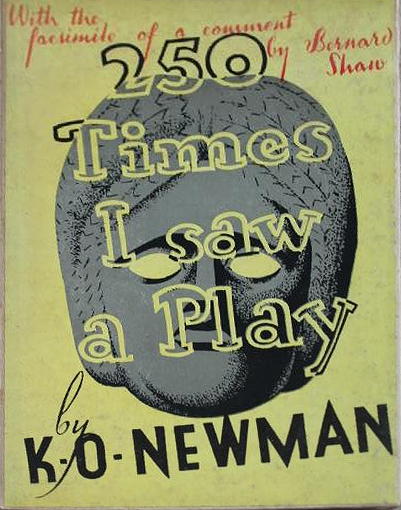
The backstory here is that Newman was Rattigan's doctor. According to TactNYC.org:
For some reason, Rattigan asked Newman to personally direct the performance of the lead actor in the play, Jack Watling, and Newman proceeded to become obsessed with Watling. Which is why, I assume, Newman ended up watching the play 250 times. Rattigan's biographer, Geoffrey Wansell, offers more details:
At this stage Newman had not made a homosexual pass at Watling. That came later. Newman simply frightened him beyond words. 'I couldn't do anything without asking his permission. I was heterosexual then, and I am now, but Newman pretty much gave me a nervous breakdown. I couldn't cope with him.' Why Newman had this power, or why people submitted to him, Watling is just as unable to explain now as he was then.
After completing his odd book, Newman sent the manuscript to George Bernard Shaw, who wrote back with a few of his thoughts about it. Shaw's comments weren't very complimentary, but Newman nevertheless included a facsimile of them at the front of the book. Shaw wrote:
Sure enough, Newman was subsequently certified insane and died in a mental institution.
Posted By: Alex - Mon Nov 02, 2020 -
Comments (1)
Category: Theater and Stage, Books, 1940s
Demoralize Nazis with tea
1940: Stephens Fothergill of London had a very British plan to defeat the Nazis:
St. Louis Post-Dispatch - Feb 15, 1940
Posted By: Alex - Wed Oct 28, 2020 -
Comments (2)
Category: Military, War, 1940s
My Old Flame
A song that goes rapidly off the rails around the one-minute mark, with some Halloween relevance.
Posted By: Paul - Sun Oct 25, 2020 -
Comments (4)
Category: Hoaxes and Imposters and Imitators, Horror, Music, 1940s, Parody
Ruby Barnett, machine-gun tester
Mrs. Ruby Barnett was one of 1000 women employed at the Aberdeen Proving ground during World War II. Her job there was to test guns, and she attracted quite a bit of media attention because she was a grandmother and didn't exactly look like the kind of person one would expect to see behind a .50 caliber machine gun.Apparently she was only 40, but she already had three grandkids.
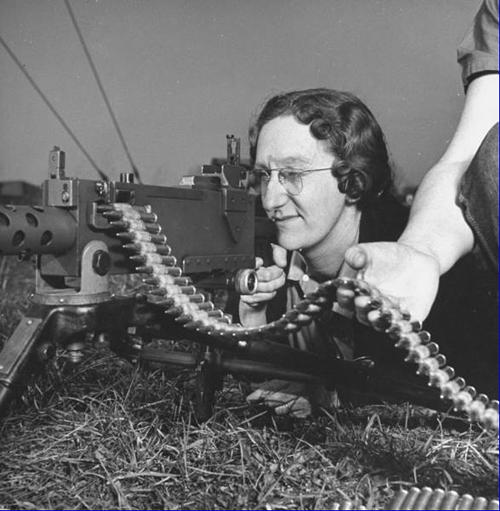
Source: Google Arts & Culture
Mrs. Ruby Barnett, 40, said today as she went about her job of testing all kinds of guns—except 16-inch cannon—that she found nothing inconsistent in gun-firing by day and rocking the cradle of her third and newest grandchild by night.
"Hitler hasn't respected grandmothers or little children in this war and I guess American grandmothers will have to pitch in and fight him any way they can," she said, as she turned from the anti-tank gun, loaded a .50 caliber machine-gun and banged away with nonchalance and a terrific din.
The youthful grandmother, wife of a World War veteran, is employed by the Army, along with 1,000 other women, to test ordnance materiel at the government's oldest and largest proving ground here.
Wilmington Morning News - Oct 2, 1942
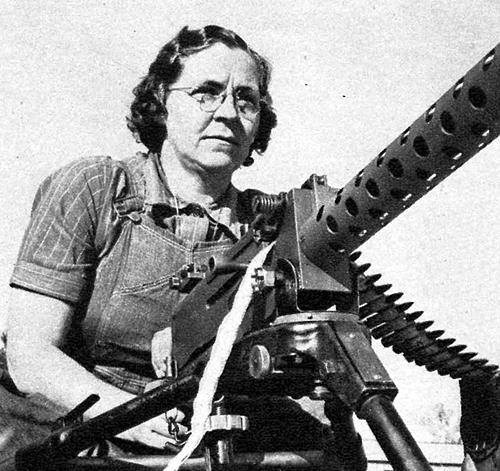
Source: OldMagazineArticles.com
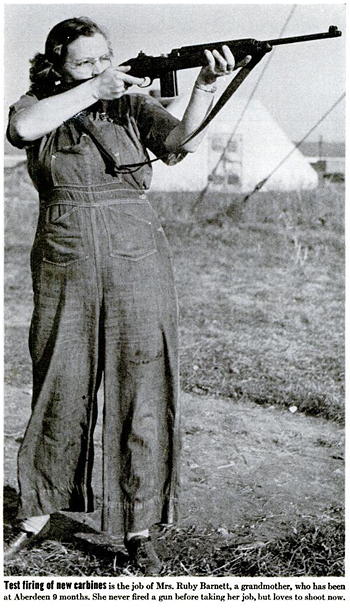
Posted By: Alex - Wed Oct 14, 2020 -
Comments (8)
Category: 1940s, Weapons
Parkinson’s Dream Weapon
How, in 1940, a Bell Labs engineer invented a guidance system for anti-aircraft guns in a dream. Source: The Bigelow SocietyA compelling example in favour of this theory concerns an engineer, David Bigelow Parkinson. The time was spring, 1940 and Parkinson was then a young engineer working at Bell Telephone Laboratories in New York City in the specialized field of electromechanical design. He was working on improving an instrument called an automatic level recorder. A small potentiometer [an instrument for measuring electromotive forces] controlled a pair of magnetic clutches which in turn controlled a pen to plot a logarithm.
Meanwhile, the top story in the headlines concerned the evacuation of hundreds of thousands of stranded Allied soldiers from the beaches of Dunkirk, France across the Channel to England. This news greatly preoccupied Parkinson's mind along with that of his work. And the two ideas came together in a dream, which he later described in an unpublished memoir:
I found myself in a gun pit or revetment with an anti-aircraft gun crew . [A] gun there. was firing occasionally, and the impressive thing was that every shot brought down an airplane! After three or four shots one of the men in the crew smiled at me and beckoned me to come closer to the gun. When I drew near he pointed to the exposed end of the left trunnion. Mounted there was the control potentiometer of my level recorder!
Parkinson realized the full significance of his dream the following morning. If his potentiometer could control the pen on the recorder, something similar could, with the right engineering, control an anti-aircraft gun. At the time, the complex mechanical systems controlling these guns were not very accurate and could not be mass-produced.
Parkinson discussed the idea that morning with his boss, Clarence A. Lovell. They worked for several days writing a report and then met with Lovell's boss. Just before this meeting, on 18 June 1940, Parkinson realized he would need a diagram to explain his ideas so made a quick sketch on a sheet of plain white typingpaper.
The company submitted a proposal for exploratory work on an electromechanical system for directing antiaircraft guns to the Army Signal Corps which was subsequently approved. An engineering model was delivered for testing to the Army at Fort Monroe MD on 1 December 1941. The result of Parkinson's dream began rolling off the assembly lines early in 1943. More than 3000 of the gun directors, designated the M-9, were built.
Many thousands of shells were fired to bring down a single aircraft with the older directors; the M9 brought the number down to around 100 shells per hit on an aircraft.
Thus Parkinson's unconscious revelation led to one of the most effective pieces of air-defense technology in World War II.
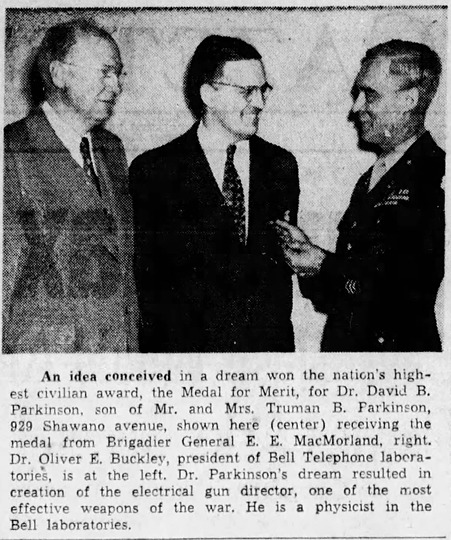
Green Bay Press Gazette - Apr 22, 1947
Posted By: Alex - Thu Oct 08, 2020 -
Comments (3)
Category: Sleep and Dreams, 1940s, Weapons
Human Blood Pudding
Dr. Magnus Pyke was a scientific advisor to the British Ministry of Food during World War II. In 1969, during a lecture at the Royal Institution in London, he revealed the following:At that time large amounts of human blood were collected from such people as were prepared to give it. The blood was centrifuged, the plasma put aside for parenteral injection into those victims of bombing that might need it, and the red corpuscles discarded.
Again the scientific advisers to the minister of food put forward a scheme to make use of the red-blood corpuscles, so self-sacrificingly contributed by patriotic donors, and manufacture from it black pudding for distribution on the food ration.
The curious anthropological phenomenon then emerged that although the British were prepared to consume each other's blood by vein, they considred its ingestion by mouth was a variant of cannibalism and therefore disgusting.
They could have called it Soylent Black.
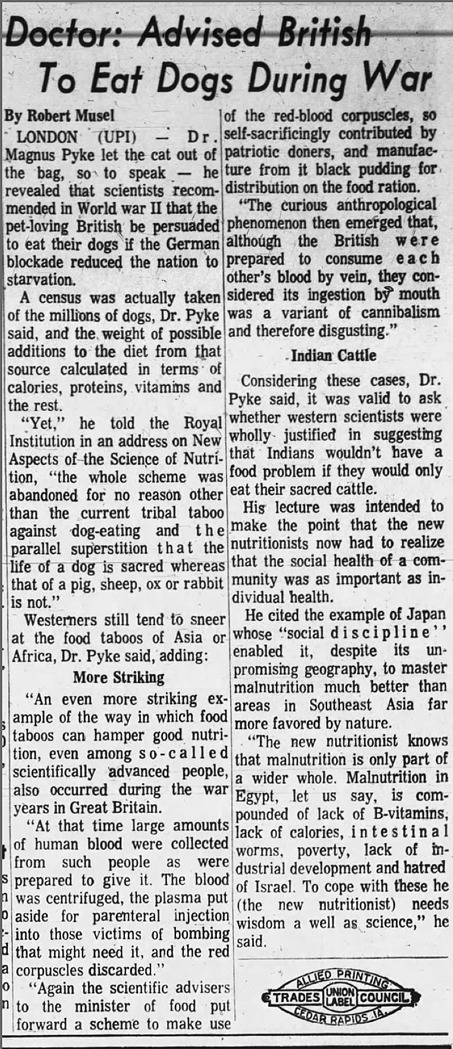
The Cedar Rapids Gazette - Dec 18, 1969
Posted By: Alex - Wed Oct 07, 2020 -
Comments (3)
Category: Cannibalism, Food, 1940s, Blood
Baby, the Seeing-Eye Cat
1946: Carolyn Swanson of Hermosa Beach, California made headlines on account of Baby, her "seeing-eye cat." Somehow she had trained him to assist her as she walked around town.— The Redondo Reflex - Dec 13, 1946
More info: life



Brattleboro Reformer - Dec 17, 1946
Posted By: Alex - Mon Oct 05, 2020 -
Comments (2)
Category: Cats, 1940s, Eyes and Vision
The Duchess of Windsor’s Trench Mittens
Wallis Simpson, the Duchess of Windsor, is best known as the woman for whom King Edward VIII abdicated the throne in 1936, so he could marry her. But she was also an inventor, though not a very prolific one. In 1940, she invented "trench mittens" that could be unzipped to allow a soldier to use his trigger finger.
The Whitewright Sun - Feb 8, 1940
The backstory is that the Duke and Duchess were widely suspected to be Nazi sympathizers. Nevertheless, at the start of the war they were trying to make a public display of how patriotic they were. The Duke pushed to get a position in the army. And the Duchess used her fashion skills to invent "trench mittens".
But by the end of 1940, the British military had decided they were too much of a liability to keep around, so they were shipped off to the Bahamas for the duration of the war.

Winnipeg Tribune - Apr 6, 1940

The Duke and Duchess of Windsor in 1937
Posted By: Alex - Fri Sep 25, 2020 -
Comments (1)
Category: Fashion, Royalty, War, 1940s
Dali’s Drunken Montage from MOONTIDE
Surrealist Salvador Dali was hired to create the drunken montage at the top of the story but his sketches were deemed too bizarre, and the scene was shot with only some of his influence (most likely the close-up of the clock, the headless woman) intact.
Wikipedia source.
Posted By: Paul - Sat Sep 05, 2020 -
Comments (3)
Category: Movies, Surrealism, 1940s
Horizontal Theater
Back in 1945, Thomas Curtis Gray of Washington, DC was granted a patent for a theater in which the patrons would view the movie while lying-down. To facilitate this, the movie was projected onto a screen anchored to the ceiling.Gray argued that his horizontal theater had several advantages over a traditional theater. First, it would be more comfortable to watch a movie while reclining. Second, a patron's view would never be obstructed by someone in front of them. And finally, the screen could be located at a closer-to-equal distance from all viewers.
I've never heard of a horizontal theater being built. But arguably his patent foreshadowed the rise of the modern-day luxury cinemas where you can relax in seats that recline almost all the way back.

Posted By: Alex - Sun Aug 09, 2020 -
Comments (0)
Category: Architecture, Inventions, Patents, Movies, 1940s

| Who We Are |
|---|
| Alex Boese Alex is the creator and curator of the Museum of Hoaxes. He's also the author of various weird, non-fiction, science-themed books such as Elephants on Acid and Psychedelic Apes. Paul Di Filippo Paul has been paid to put weird ideas into fictional form for over thirty years, in his career as a noted science fiction writer. He has recently begun blogging on many curious topics with three fellow writers at The Inferior 4+1. Contact Us |




